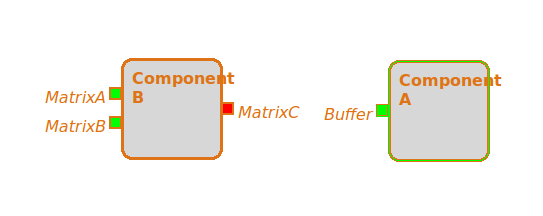看完前面三篇文章,相信大家对elefant都有一个比较初步的认识了。那么这节我们来看看怎样将自己的算法作为新组件添加到GUI中去,这才是我们最想要的。
加入自己的算法
如何加入自己的算法,官方文档里有简单的说明,但不完整,我是通过看一个NICTA的暑期学校视频(页面点进去一个老头讲的,有三段)而明白的。首先,我们需要找到Elefant的安装路径,为了找这个我费了半天劲,最后动用了终端的find命令,终于找到奔图下的路径为:/usr/local/lib/python2.6/dist-packages/elefant
在这个目录下我们可以发现一个components子目录,其下有一个user目录,我们以后自己添加的组件(即py文件)就需要放在这里。注意到这里有一个叫example.py的文件,这就是官方给我们的例子了。
1 | from elefant.framework.core.ports import IN_PORT, OUT_PORT |
相信有了前面的基础,再看这段代码应该不算太烦吧。首当其冲的是把需要的类Import进来。我们看这个py文件声明了两个组件CompA和CompB,我们发现是以类的形式出现的。通过comp_name属性为组件定义名称,即在GUI里显示的名称,通过CCustomProperty()我们可以为组件定义属性,四个参数分别是:类型,默认值,大小范围,说明。在init方法中为组件添加端口及协议,我们必须牢记:### 端口之上有协议,协议之上绑定数据。组件A提供两个矩阵。组件B中定义了一个非私有的方法(Python中以双下划线开头的都是私有的):DoProduct(),这个方法计算两个矩阵的乘积。在mian()方法中进行测试,当然,你也可以写到别的py文件中去。可以看到,依然是老套路:实例化组件—->Connect端口—->调用各个组件的方法。
在这个文件夹下我们还能发现一个__init__.py的文件[注意该文件为只读的,改动时需要使用chmod命令改成可写],如果我们添加自定义的组件,这个文件起着至关重要的作用:我们必须将自定义组件的名称写进这个文件中去,打开文件,我们可以看到只能一行:
1 | __GUI_PKG__ = ['example','MHKS','MatMHKS'] |
结果很简单,我们需要将自己添加的py文件的文件名添加到中括号内,上面本人已经添加了两个算法,即MHKS和MatMHKS [貌似example加不加都可以]。然后我们打开GUI,在算法菜单下的user algorithms子菜单项中,我们可以发现刚才example中的组件A和B了。

总结一下,添加自己的组件有两个要点:一,py文件放到指定文件夹中;二,改动__init__.py文件内容。有的时候我们发现新添加组件后GUI无法执行了,这时我们可以在终端里执行launchelefant.py命令打开GUI,如果无法启动会报错,一般的错误就是你新添加的组件的__inti__.py文件出错;有时还会碰到这样的情况,打开了GUI但打不开自己的组件,这是因为你的组件中__init__()方法出错,因为当你点击组件时会调用该组件的__init__()方法组件才能显示出来,无法显示时请检查你的__init__()方法方法。